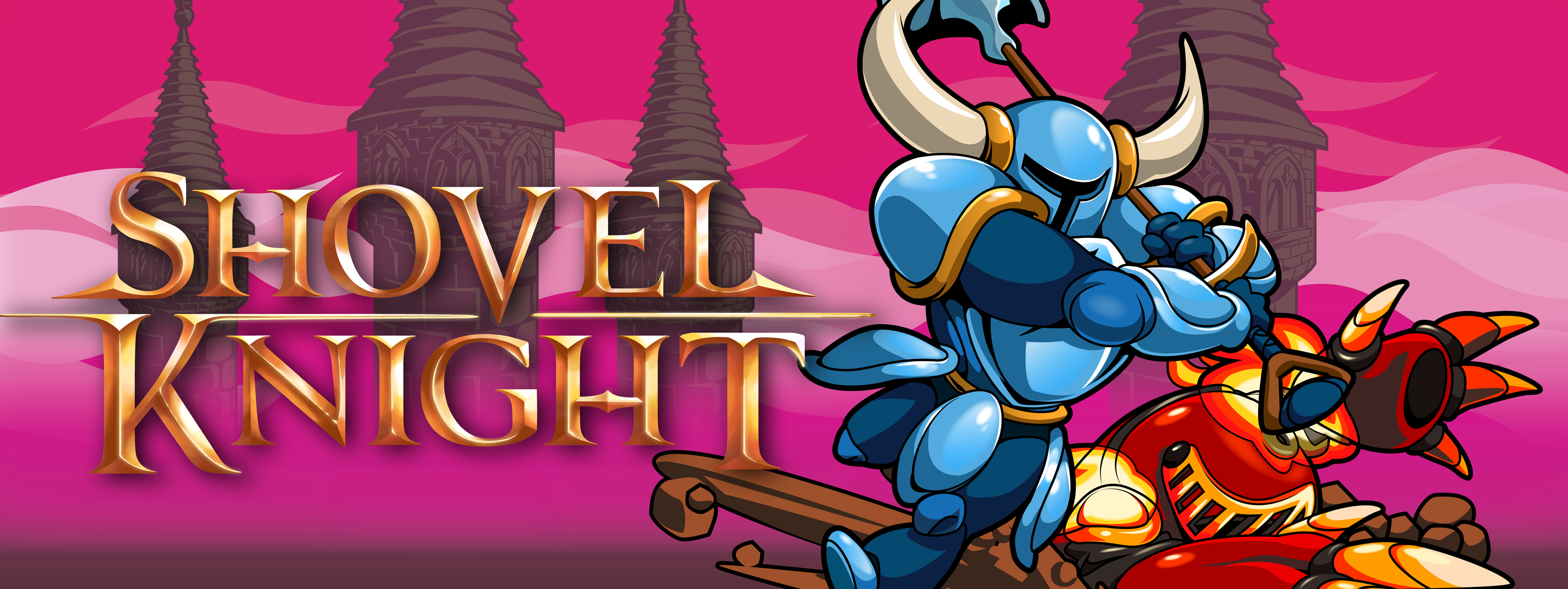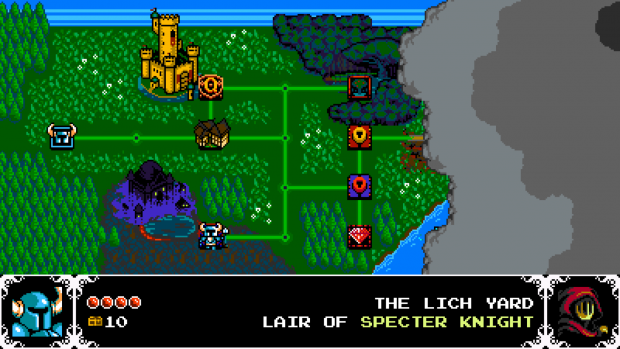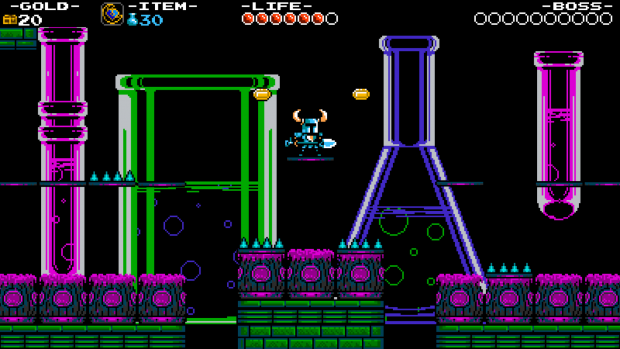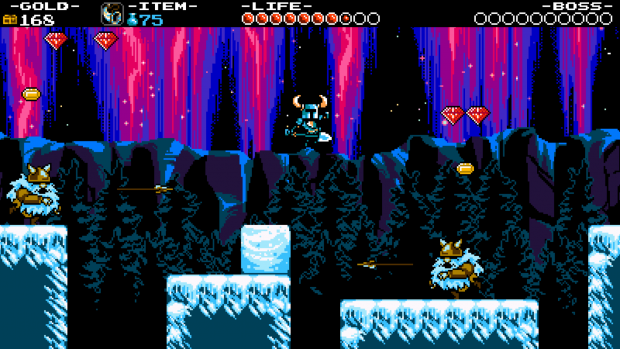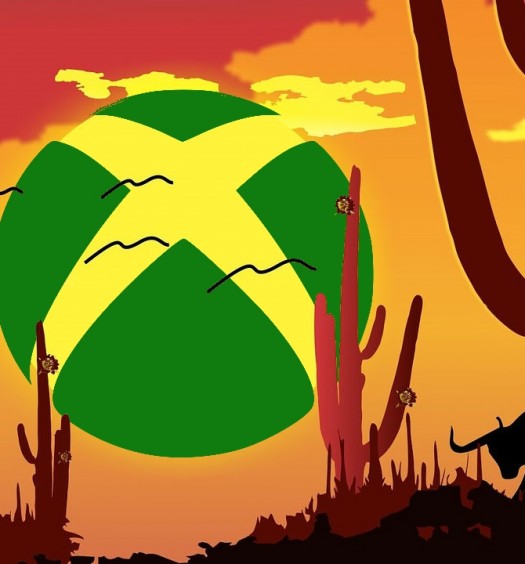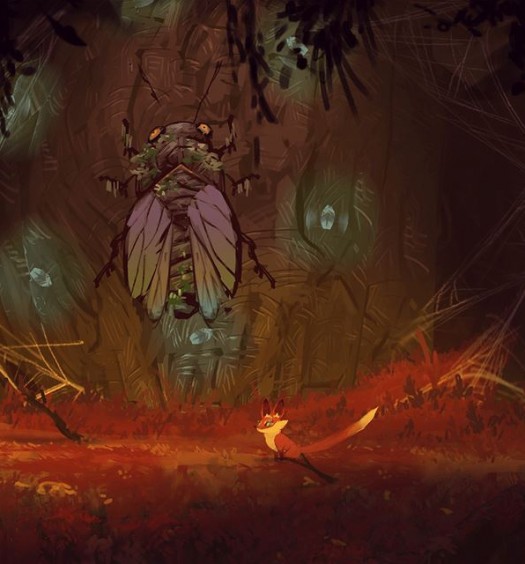Shovel Knight was developed and published by Yacht Club Games on Xbox One. It was released on April 29, 2015 for $14.99. A copy was provided for review purposes.
So this review is a little late. Why, you ask? Five hundred and forty-three deaths, that’s why. I played Shovel Knight for a little over 16 hours, but at times it felt like a lifetime. I cried (not kidding, but I do cry pretty easily), I screamed, I cursed at the television and I threw my controller on multiple occasions. I asked myself several times, “Who the hell would actually enjoy playing this game?” But when it was all said and done, I had my answer — me. Shovel Knight will try your patience from the start, but it will also suck you in and provide hours of quality gaming.
Here’s what I liked:
8-bit nostalgia — If you’re going to try and create an old-school, side-scrolling platform game, then you better do it right. Shovel Knight’s graphics give the 8-bit feel but still have the crispness that you’d expect from a modern game. Yacht Club Games pays homage to all the classics not just through its art style, but also through gameplay and storylines. You’ll frequently find yourself saying that something is “just like” the Hammerhead Bros in Super Mario Bros, the cane-pogo jumps of Ducktails or the boss fights in Mega Man. For anyone who grew up playing games in the ’80s this is a feeling that can’t be beat. Today’s games are amazing, and the things that we can do now are incredible, but there is something about a game like this that modern graphics just can’t compete with. Shovel Knight doesn’t rely on fancy graphics or exploring vast open worlds to wow players; it entertains you and challenges you with gameplay alone. The soundtrack of Shovel Knight is also filled with great 8-bit tunes. Clearly the developers knew this, as a large sidequest involves collecting music sheets that you can then take to the bard who will not only play them for you, but will also give you money for them.
The bosses — Every level ends with a boss fight against another knight. Each knight has his own persona, and the design of the level corresponds to that, very similar to how it was done in classic Mega Man games. No two boss fights are the same or even close to the same. Each boss has his own special skills and weaknesses. This is definitely a nice diversion from some NES where pretty much every boss was the same but just wearing a different outfit (we all remember just jumping on every boss’ head three times to kill him). You will have to pay very close attention to Shovel Knight‘s boss’ every move, figure out the perfect timing and then hold your breath as you cling to the last few hit points trying to finish them off.
The secrets -– Secrets have been an institution in games for as long as anyone can remember. Finding these secrets has been engrained in every gamer since the first time they picked up a controller, and Shovel Knight continues the trend with an abundance of secrets. Finding and collecting relics and gems is a nice diversion from the regular chaos of levels; though sometimes you’ll find that certain secrets will cause you more death and money than they’re worth.
Here’s what I didn’t like:
The length of each level — Every level took me an average of one hour to beat. The levels have checkpoints throughout, but the difficulty to reaching them seems completely arbitrary. Sometimes I would get to a checkpoint on the first try and not die once along the way; other times I would die what felt like 50 times before reaching the next checkpoint. It was extremely frustrating to so frequently have play the same section over and over again until I reached the next checkpoint. Compounding that frustration was the issue of the time commitment. Each time I sat down to play the game I knew it would be at least a one-hour commitment, which may or may not be less of an issue for players than for reviewers. There were multiple occasions where I could spare a half hour to play, but I knew that wouldn’t be enough to finish the level. A few times I would start a level and then have to leave to go to work or another engagement. I’d be left with no choice but to quit the game, forfeit all my progress, and start over again the next day. This is in keeping with classic game design, but it’s one throwback that Shovel Knight would have been better without.
The money system — I have a love/hate relationship with Shovel Knight‘s money system. Every time you die you lose bags of your money, and money is used to level up your character, so having more is obviously better than having less. I appreciate the fact that this adds an additional challenge to the game and forces you to strategize as to when to spend your money and incentivizes players to go back to replay older levels to earn more cash. However, the problem is that half the time when you die it’s because you fell down a hole. When you fall down these holes, your money stays down the hole as well, meaning that in order to collect your money you’d have to jump down the hole again. No one is going to do that, so clearly that money is then lost forever. Furthermore, money does not consistently end up where you died. Sometimes your money does the opposite and flies off in all crazy directions above your head after dying. Thus posing the problem of how do you get up there when you weren’t even there in the first place?
Wrap-Up:
The truth is that Shovel Knight is a blast to play when you’re not up against a time constraint. The graphics, music and gameplay are all outstanding. I couldn’t wait to finish everything, mainly so I could get this review done, but now I keep thinking about going back and playing more. Even after completing it, there is still a lot to be done. Upon completion of the storyline, I had only collected 51 percent of items, and I could easily spend another 5-10 hours on upping that percentage. At only $14.99, Shovel Knight is a steal.
Score: Buy It
Post-credits note: Make sure you watch Shovel Knight‘s entire credits. Not only is there more story post-credits, but you will also get your scoreboard at the end of the credits and see you how many times you died in each level, total deaths, time played and more. Seeing how many times you died to get there makes victory that much sweeter.

